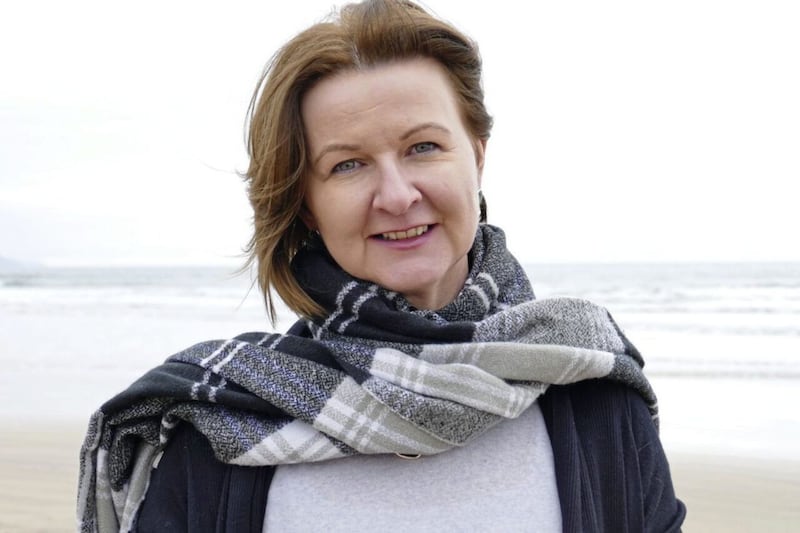NUALA Byrne was, by her own account, still very young when she first started hearing things that other people didn't hear – although, at first, she confused the voices she heard with "living voices" and would answer someone "who wasn't really there".
She also saw a girl who wasn't there; a young girl with "sun darkened skin and blue eyes the shape of plum stones" set in a face "not given to much mirth".
While the dead of Rathlin Island didn't usually reveal themselves in the flesh, so to speak, Nuala often heard them. This one, however, remained silent...
And so the reader is introduced to the enigmatic leading character in The Watch House, the new novel from the pen of respected Northern Ireland author Bernie Magill, which is being officially in her hometown of Portstewart tonight by Belfast author and journalist Eimear O’Callaghan.
Having lived by the shores of the popular seaside town for over 20 years, Magill (author of critically acclaimed The Butterfly Cabinet, published in 2011 and the Sleepwalkers short stories collection, shortlisted for the Edge Hill Short Story Prize), is well accustomed to the lulling notes of the sea and is a regular visitor to Rathlin Island where her historical fiction is set.
The year is 1898 and a vividly imagined love story is cleverly woven into the excitement of a real historical event when engineers working for Italian-born radio inventor, Guglielmo Marconi, arrive on the tiny north coast island to carry out investigations into early wireless telegraphy.
"At that time, cargo ships crossing the Atlantic would travel down the channel between Ireland and Scotland and the business people involved had a vested interest in finding out that their shipments were safe," McGill explains. "Up until messages could be sent by radio waves, people on Rathlin would communicate using semaphores such as flags.
"Carrier pigeons were also used but they weren't found to be that successful due to the fog and also because the island hawks would tend to eat them. With the arrival of Marconi, the aim was to set up a wireless link between Rathlin Island and Ballycastle and get valuable information sent to London in the quickest possible time."
Marconi, who was then based in London – he later paid a visit to Rathlin in person – had earlier met with Sir Henry Hozier, secretary of Lloyd’s insurers of London, and was offered a contract to set up a wireless link between the island and the Northern Ireland mainland.
Rathlin was said to have been a pivotal link in the chain of information, due to the fact that all shipping traffic passed by its easterly lighthouse en route for Liverpool, then the largest port in the UK.
McGill, herself brought up in a small townland called Lavey, near Bellaghy, Co Derry, was fascinated by this history and felt a familiarity with the island and its "one church, one pub, one shop" mentality.
She had also "fallen in love with the place" ever since her first visit in 2002 as a participant in a writing festival organised by Ballycastle Writers' Group.
Describing her latest offering as a "dark love story in a big tangled web" and set on an island "alive" with gossip, suspicions and secrets, the Queen's University (English and Italian) graduate also likes to think The Watch House will serve as a vehicle to spark renewed interest in the island's history and its link to the famous radio pioneer.
"I loved learning about the radio technology but I'm not at all a radio buff, so it was challenging trying to grasp it all, as I hadn't a clue how the whole thing worked," says the writer who previously worked in administration and fundraising with the Big Telly Theatre Company in Portstewart.
"I decided, though, it was more a story to do with linguistics and communication, so I tried to avoid getting too bogged down in the minutiae of the scientific process.
"When the strangers arrive on the island with their mysterious equipment, the islanders don't understand it either – how can machines steal a person's words and transmit them through thin air?"
The stage is set for further imbroglio when Nuala, who settles for a type of "marriage of convenience" to the island's ageing tailor, meets exotic Italian engineer Gabriel and, in him, finds "a new tune, a tremble that grows like the first test notes of the fiddle".
McGill, who is married with two grown-up daughters and draws on a "great tradition" of storytelling and music on both sides of her family, writes the love scenes with subtlety, aided by the soft breath of a poet: "the colours coming all at once, like the splintering of a stained glass window..."
For the historic elements, she took herself off to the Bodleian Library, Oxford (research library for the university and one of the oldest libraries in Europe) with the help of a grant from the Society of Authors and also paid several visits to Rathlin Island itself, to soak up its own hypnotic rhythms.
"There was quite a lot of research involved, but I thoroughly enjoyed it and kept unearthing new snippets of information," she says. "In Oxford, I was able to study the maps and diaries of George Kemp, Marconi's right-hand man, so that helped clarify what they were trying to do.
"It was sad, too, to learn how an Irish engineer, Trinity graduate Edward Glanville, fell to his death from cliffs on Rathlin, during the experiments. Today, there is a plaque on the island which commemorates his work, along with that of Marconi and Kemp and their successful efforts in creating the first commercial telegraphy link in the world.
"It amazes me to think that Rathlin Island, with a population of around 150 and where residents still get cut off by bad weather, was at the forefront of development of modern wireless technology."
:: The Watch Tower by Bernie McGill – published by Tinder Press – is being launched tonight at Flowerfield Arts Centre, Portstewart, at 7pm, in association with the John Hewitt Society. There will also be readings of the book at Aspects Festival, Bangor, this Sunday (September 24), between 3 o'clock and 4.30.






